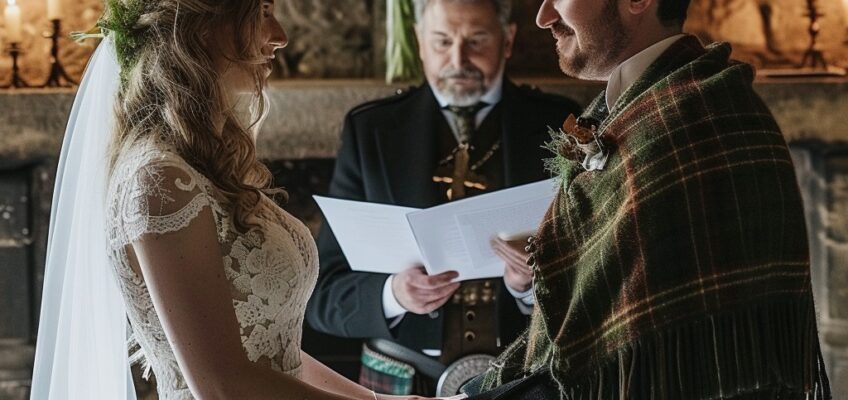Traditional weddings can vary greatly depending on the culture, but they typically focus on timeless rituals and symbols of unity, family, heritage and customs.
1. Classic Ceremony Attire
- Bride: A traditional white or ivory gown, possibly with lace or embroidery, representing purity and new beginnings.
- Groom: A formal suit or tuxedo, with a classic tie or bow tie. In some cultures, grooms wear traditional garments like a kilt (Scottish), sherwani (Indian), or morning coat (English).
2. Vows and Rituals
- Exchanging Vows: A formal exchange of vows, sometimes including promises made in front of family and friends.
- Unity Candle or Sand Ceremony: A symbolic act where the couple light a single candle or pour sand into a shared container, representing the joining of two lives.
- Handfasting: A tradition where the couple’s hands are tied together with a ribbon or cord, symbolizing their commitment.
3. Traditional Music
- Choose music that is traditional to your culture or something classical. A string quartet or a traditional live band could add a beautiful, timeless feel.
- The wedding march is often a traditional choice for the processional.
4. Traditional Wedding Colors
- Western Traditions: White or ivory for the bride and darker colors for the groom (navy, black).
- Chinese Traditions: Red and gold, symbolizing good luck, prosperity, and happiness.
- Indian Traditions: Rich, vibrant colors like red, gold, and green, which hold spiritual significance.
5. Family Heirlooms
- Incorporate family traditions and heirlooms, such as wearing a family wedding ring or passing down a piece of jewelry (e.g., a grandmother’s necklace or the bride’s something old).
6. Reception Traditions
- First Dance: The newlyweds share their first dance, often with a slow, meaningful song.
- Cake Cutting: The couple traditionally cuts the wedding cake together, symbolizing their shared life ahead.
- Tossing the Bouquet and Garter: A light-hearted tradition where the bride tosses her bouquet to unmarried women and the groom tosses the garter to unmarried men, symbolizing the next to marry.
7. Traditional Food and Drink
- Consider serving dishes that have significance in your culture or that represent your heritage. For example, a hearty roast dinner or regional specialties.
- For drinks, a classic champagne toast is a staple, or you could include traditional drinks like sake, mead, or wine, depending on your background.
8. Cultural and Religious Traditions
- Depending on your faith or cultural background, there may be specific rituals to include. For example, a Catholic wedding mass, a Jewish chuppah ceremony, or a Hindu fire ceremony.
- Some cultures also have post-wedding traditions, like a “tea ceremony” or a “wedding procession” that celebrates the couple’s new life together.
9. Traditional Wedding Flowers
- Western Traditions: Roses, lilies, peonies, and ivy symbolize love, purity, and beauty.
- Indian Traditions: Marigolds and jasmine are common, representing joy, love, and a spiritual connection.
10. Meaningful Favors
- Wedding favors can reflect the cultural significance of the wedding. In some cultures, guests receive small tokens, like almonds (in Italian and Middle Eastern traditions), or sugar cubes (in Greek weddings) to symbolize sweetness and well-wishing

